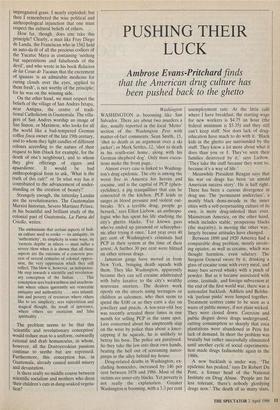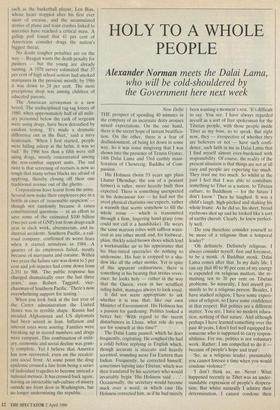PUSHING THEIR LUCK
Ambrose EvanyiPritchard finds
that the American drug culture has been pushed back to the ghetto
Washington WASHINGTON is becoming like San Salvador. There are about two murders a day, usually reported in the local 'Metro' section of. the Washington Post with matter-of-fact comments: Sean Smith, 15, 'shot to death in an argument over a ski jacket'; or Mark Settles, 12, 'shot to death in his south-east home, along with his German shepherd dog'. Only mass execu- tions make the front page. .
Almost every case is linked to Washing- ton's drug epidemic. The city is among the worst five in America for heroin and cocaine, and is the capital of PCP (phen- cyclidine), a pig tranquilliser that can be concocted in the kitchen. PCP leads to surges in blood pressure and violent out- breaks. 'It's a terrible drug, people go berserk,' says Elliot Liebow, an anthropo- logist who has spent his life studying the city's ghetto blacks. 'I've known guys who've ended up paranoid or. schizophre- nic after trying it once.' Last year over 40 per cent of Washington's criminals had PCP in their system at the time of, their arrest. A further 30 per cent were blitzed on other serious drugs.
Jamaican gangs have moved in froth New York, bringing death squads with them. They like Washington, apparently because they can sell cocaine adtilterated with baby laxative to the city's wealthy nouveaux snorters. The dealers work openly on the streets using teenagers or children as salesmen, who then seem to spend the $100 or so they earn a day on jewellery and pistols. A ten-year-old boy was recently arrested three times in one month for selling PCP in the same spot. Less concerned about his umpteenth slap on the wrist by police than about a knee- capping if he squeals, he is unlikely to betray his boss. The police are paralysed. So they take the law into their own hands, beating the hell out of screaming narco- pimps in the alley behind my house. Drug-related deaths in Washington, ex- cluding homicides, increased by 140 per cent between 1978 and 1986. Most of the victims are inner-city blacks. Yet poverty is not really the explanation. Greater Washington is booming, with a 3.3 per cent unemployment rate. At the little café where I have breakfast, the starting wage for new workers is $4.75 an hour (the federal minimum is $3.35) and they still can't keep staff. Nor does lack of drug- education have much to do with it. 'Black kids in the ghetto are surrounded by the stuff. They know a lot more about what it does than you or I. They've seen their families destroyed by it,' says Liebow. `They take the stuff because they want to, because it's a way of life.'
Meanwhile President Reagan says that his war on drugs has been 'an untold American success story'. He is half right. There has been a curious divergence in drug use. The 'permanent underclass', a mostly black demi-monde in the inner cities with a self-perpetuating culture of its own, is more drug-infested than ever. Mainstream America, on the other hand, which includes stable, prosperous blacks (the majority), is moving the other way, largely because attitudes have changed.
Between 1890 and 1920 America had a comparable drug problem, mostly involv- ing opiates, as well as cocaine, which was thought harmless, even salutary. The Surgeon General swore by it, drinking a glass of cocaine tonic with every meal, and many bars served whisky with a pinch of powder. But as it became associated with crime, lassitude, and foreign subversion at the end of the first world war, there was a nationalist backlash. Addicts and Bolshe- vik 'parlour pinks' were lumped together. Treatment centres came to be seen as a waste of public money, if not plain wicked. They were closed down. Coercion and public disgust, drove drugs underground, cutting consumption so sharply that coca plantations were abandoned in Peru for lack of demand. In short the problem was brutally but rather successfully eliminated until another cycle of social experimenta- tion made drugs fashionable again in the 1960s.
A new backlash is under way. 'The epidemic has peaked,' says Dr Robert Du Pont, a former head of the National Institute on Drug Abuse. 'People are far less tolerant, there's nobody glorifying drugs now.' The death of so many stars, such as the basketball player, Len Bias, whose heart stopped after his first ever snort of cocaine, and the accumulated stories of plane and train crashes linked to narcotics have reached a critical mass. A gallup poll found that 41 per cent of Americans consider drugs the nation's biggest threat.
No doubt tougher penalties are on the way — Reagan wants the death penalty for pushers — but the young are already turning. A 1978 survey estimated that 37 per cent of high school seniors had smoked marijuana in the previous month; by 1986 it was down to 24 per cent. The most precipitous drop was among children of educated parents.
The American serviceman is a new breed. The undisciplined rag-tag forces of 1980, when approximately half of all milit- ary personnel below the rank of sergeant were using drugs, have been detoxified by random testing. 'It's made a dramatic difference out in the fleet,' said a navy lieutenant. 'When I first started, people were falling asleep at the helm, it was so bad.' By 1986 less than a fifth were still using drugs, mostly concentrated among the non-combat support units. The sad twist is that screening of recruits is now so tough that many urban blacks are afraid of applying, thereby closing off their one traditional avenue out of the ghetto.
Corporations have learnt from the army. Several now make their employees pee in a bottle in cases of 'reasonable suspicion' though not randomly because it raises constitutional questions — in an effort to save some of the estimated $100 billion (two per cent of GNP) lost from drugs each year in slack work, absenteeism, and in- dustrial accidents. Southern Pacific, a rail- road company, confirmed its worst fears when it started urinalysis in 1984. A quarter of its employees failed, mostly because of marijuana and cocaine. Within two years the failure rate was down to 5 per cent and job injuries had come down from 2,351 to 908. 'The public response has changed dramatically over the last three years,' says Robert Taggard, vice- chairman of Southern Pacific. 'There's now overwhelming support for testing.'
When you look back at the last year of the Carter administration the United States was in terrible shape. Russia had invaded Afghanistan and US diplomats had been seized in Iran. Inflation and interest rates were soaring. Families were breaking up in record numbers and drugs were rampant. This combination of milit- ary, economic and social decline was grim- ly complete. Yet I believe that America has now recovered, even on the recalcit- rant social front. At some point the drug epidemic crossed a line from being a series of individual tragedies to become instead a national menace. It has crossed back again, leaving an intractable sub-culture of misery outside my front door in Washington, but no longer undermining the republic.



















































 Previous page
Previous page